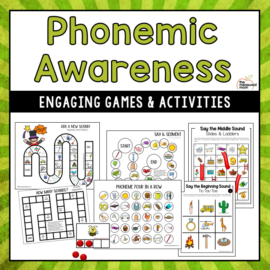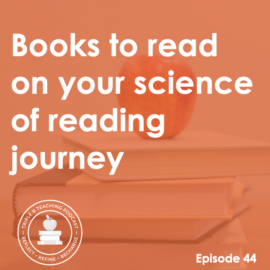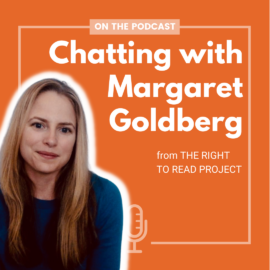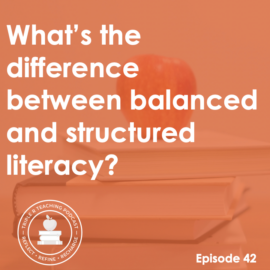
TRT Podcast#3: What did the National Reading Panel say about phonemic awareness?
What does the research have to say about phonemic awareness? In today’s episode we’ll look closely at what the NRP learned through its meta-analysis.
Listen to the full episode
Full episode transcript
It seems that whenever we're looking for a new program or resource, we find the magic words "research-based." It's kind of like the "All Natural" stamp on a box of organic Oreos. Rather than trust what everyone else says is research-based, it's smart to acquaint ourselves with the research itself.
One of the easiest ways to do this is to read the results and recommendations from the National Reading Panel, a group that spent two years studying the research surrounding the teaching of reading. Today we're finding out exactly what the National Reading Panel had to say about phonemic awareness.
Phonemic awareness is the ability to hear and manipulate individual sounds in words. For example, the word "cat" has three phonemes, /k/, /ă/, /t/. The word "ship" also has three phonemes even though it has four letters, /sh/, /ĭ/, /p/.
There are four phonemic awareness tasks: isolating sounds, blending, segmenting, and manipulating. Manipulating can include substituting, adding, or deleting sounds.
Phonemic awareness and phonics are not the same thing. Phonemic awareness has to do with the ability to hear and manipulate sounds. Phonemic awareness training may include letters, but the use of letters doesn't define it.
In contrast, phonics refers to how letters and sounds correspond to each other, and how this knowledge could help a person decode words.
As long as we're talking about words, let's talk about phonological awareness. Phonological awareness is an umbrella term that includes phonemic awareness, in addition to other skills such as syllables and rhyme.
The National Reading Panel zeroed in on phonemic awareness and that's what we're focusing on today. Their big question was, "Can you teach phonemic awareness and does it help children read more easily?"
The panel found that "phonemic awareness training was very effective in teaching phonemic awareness to students. There were large effect sizes immediately after the training and over the long term."
But that doesn't really tell us much does it? It just means that teaching phonemic awareness means that they learned phonemic awareness. So what?
Well, phonemic awareness training improved students' ability to read and spell over the long term as well. In fact, "tests of word reading, non-word reading, and reading comprehension all yielded statistically significant effect sizes." In other words, phonemic awareness training is very important for future success in MULTIPLE areas of reading.
This is the key finding of the National Reading Panel and therefore all beginning teachers of reading need to include phonemic awareness in their instruction!
When looking more closely at those studies, here's what else the panel found. Programs that focused on one to two skills yield larger effects on phonemic awareness learning than those that teach two or three skills. Instruction that taught phonemic awareness with letters helped children acquire better phonemic awareness skills than those without letters. Those students also did better with spelling. Teaching in small groups produced larger effect sizes than teaching children individually or in whole groups. Also good to know, low SES (socioeconomic status) children can benefit as much from training in phonemic awareness as middle to high SES children, despite being phonologically or culturally different.
I'd like to highlight an important note from this report. "It is important to note that acquiring phonemic awareness is a means rather than an end. Phonemic awareness is not acquired for its own sake, but rather for its value in helping children understand and use the alphabetic system to read and write. This is why including letters in the process of teaching children to manipulate phonemes is important."
A lot of times we hear that phonemic awareness is only that which can be done in the dark, that it doesn't include any print, but phonemic awareness can and often should include print so that children can make the connection to the alphabetic principle.
Now, what does the panel's meta-analysis not tell us? It does not tell us exactly how phonemic awareness instruction should be taught. It doesn't tell us exactly how much time to spend on it. It also doesn't answer some of the current questions in the science of reading community: Should we only do phonemic awareness with letters? How much time do we need to spend on advanced phonemic awareness skills like phoneme manipulation? Do we need to jump right past syllables and rhyming and go straight to phonemic awareness in kindergarten?
These are all points of debate in the science of reading community and they won't be settled until a robust body of evidence has been established. For now, keep in mind this summary from Timothy Shanahan referenced in the show notes: "Beginning readers benefit from instruction that teaches them to hear the sounds within words. This instruction prepares them for making the link between letters and sounds and should be kept simple, brief, and enjoyable. Phonemic awareness is taught through language, songs, games, and other activities that encourage students to listen for the sounds within words. Students will have successfully accomplished learning phonemic awareness when they can fully segment words with ease. For most children, this can be accomplished during kindergarten or first grade."
I'll be sure to share Shanahan's article, as well as the National Reading Panel report, and a link to an excellent phonemic awareness curriculum that incorporates letters called Road To The Code. You can find the show notes at themeasuredmom.com/episode3.
Sign up to receive email updates
Enter your name and email address below and I'll send you periodic updates about the podcast.
Related links
- The National Reading Panel Report: Practical Advice for Teachers, by Timothy Shanahan
- National Reading Panel’s report
- Road to the Code phonemic awareness program

Phonemic Awareness Games & Activities
$24.00
This bundle includes activities perfect for tutoring sessions, small group teaching, and whole class instruction!







Sheri
Anna,
I’m wondering your thoughts on “Road to the Code” vs Heggerty’s “Bridge the Gap” for use in a private one-to-one tutoring setting?
Thanks in advance for your thoughts!
Anna Geiger
I believe Road to the Code incorporates letters, while I know that Heggerty does not. So if I had to choose one, I would pick Road to the Code.
Jacqui
Hi Anna, I just found your website and I love the resources that you share. My K is in a homeschool-classroom hybrid school, so we do a decent amount of work at home and these activities fit really well with the curriculum the school uses. I was wondering if you had a list of resources/blogs, etc. with engaging activities like these for older students (Grades 3-6th)? My nephew is struggling with several subjects and I think he would be served better with more active learning strategies, so I’m trying to find some resources to use with him. Thanks!
Anna G
Not currently, I’m sorry! But I’m working on a blog post with online resources that I hope will help.
Maria Elena
Great, sometimes we under estimate the students’ capacity nevertheless they have the potential to become great writers. As teachers we just need to guide the students. I like the idea of allowing preschoolers to add on to their illustrations during the reviewing.
Thanks for sharing valuable information.
Sharon
Thank you, your tips are very informative and will be implemented. Thanks for the information about sharing I am no longer going to avoid it.
Lucrece
I really enjoyed listening to episode 3 because i realized when I was teaching kg, I was actually using most of these strategies you highlighted. Listening to your podcast has helped me to consciously reflect more on my teaching. Thank you for all you do to help your fellow educators.
Anna G
Thank you so much, Lucrece – this is wonderful to hear!